The Time of Our Lives
Accelerator presents the first solo exhibition in Scandinavia of London-based artist Sin Wai Kin (b. 1991, Toronto, CA). The exhibition spans Accelerator’s two gallery spaces and features several of Sin’s recent video works. The centrepiece is the new video installation The Time of Our Lives, from which the exhibition takes its name.
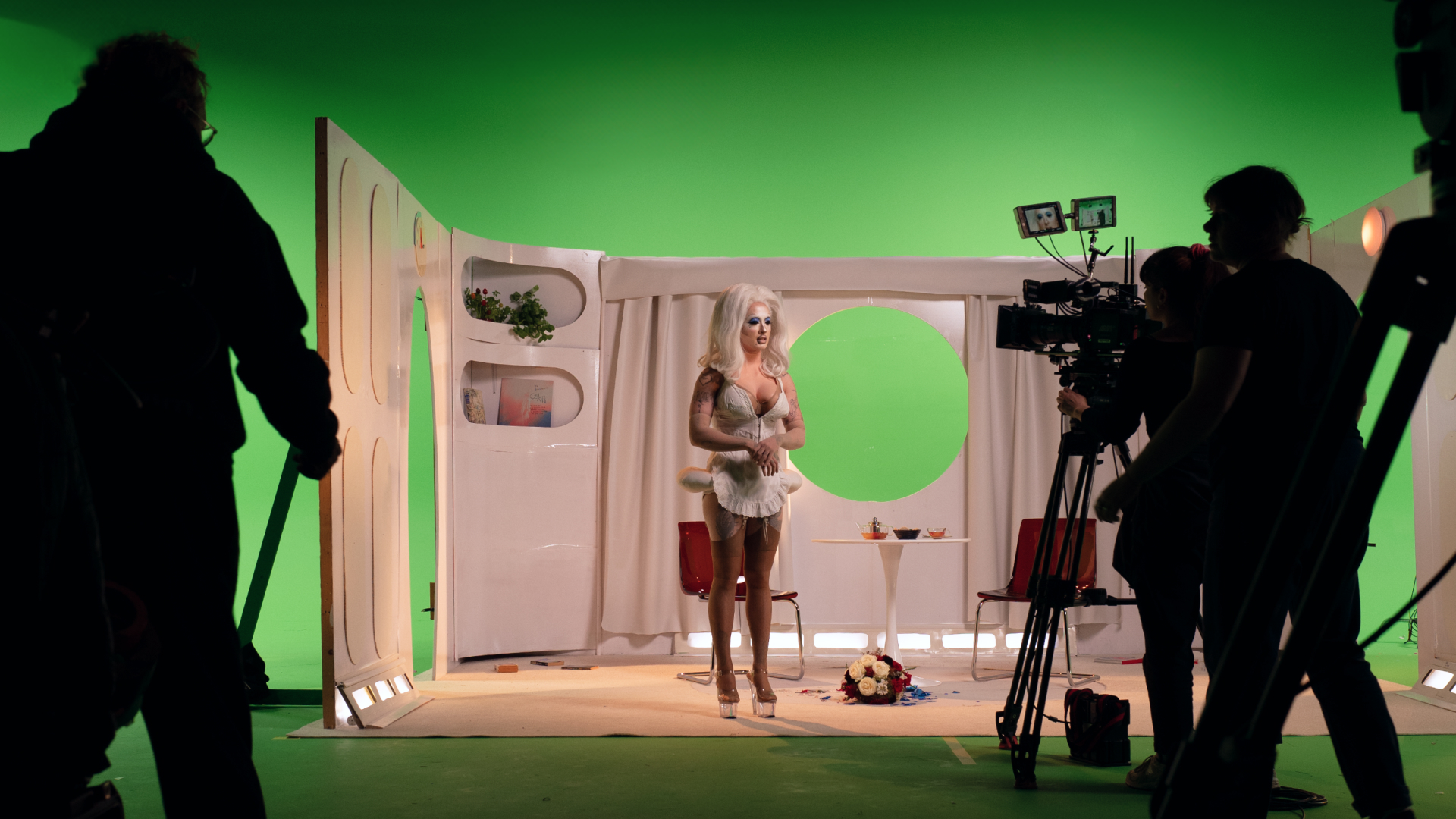 Behind the scenes during the production of the new work 'The Time of Our Lives', 2024.
Behind the scenes during the production of the new work 'The Time of Our Lives', 2024.
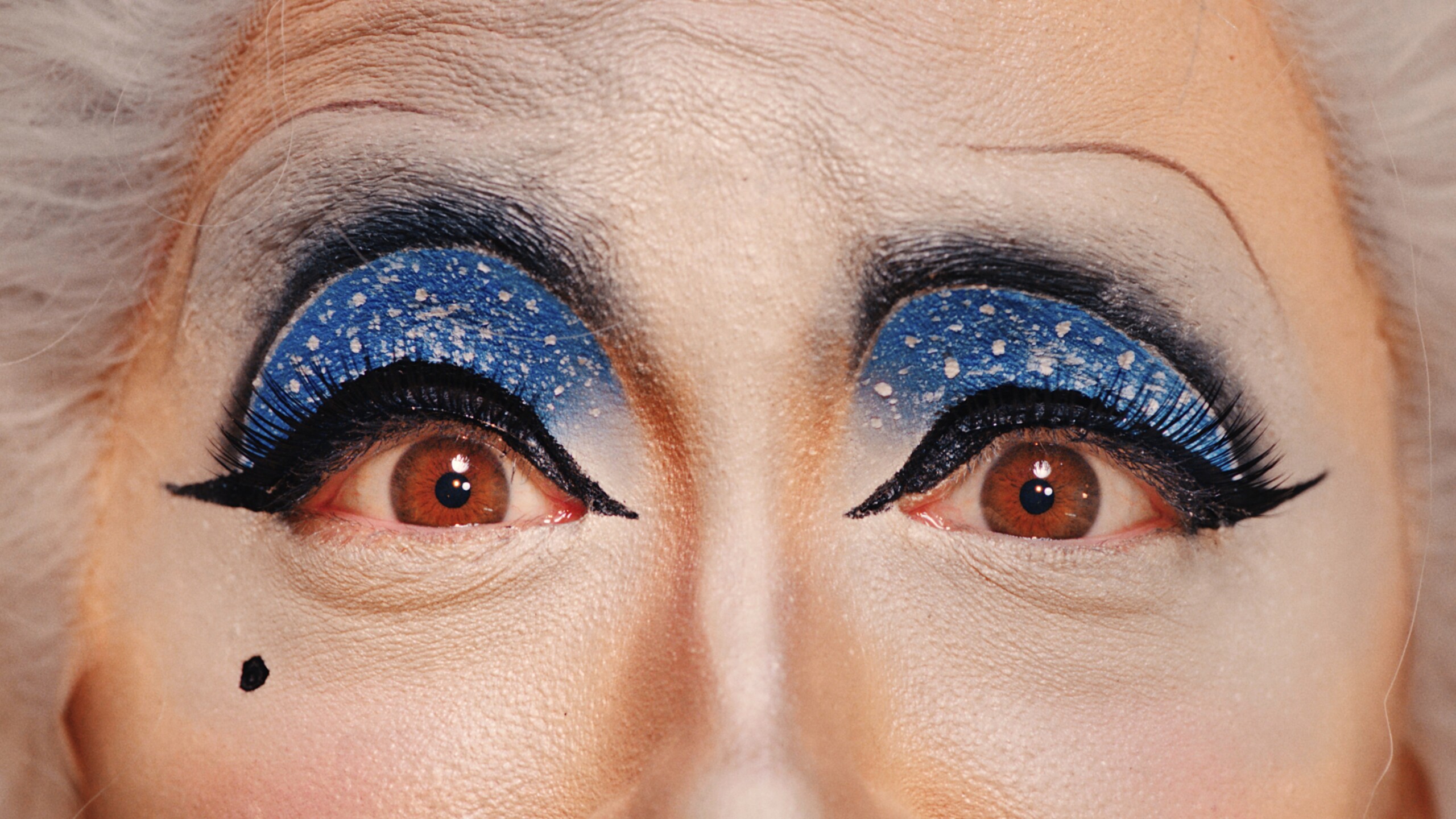 Sin Wai Kin, 'The Time of Our Lives', film still, 2024. Initiated by Accelerator and co-produced with Kunsthall Trondheim, Canal Projects, and Blindspot Gallery, supported by Vince Guo. Image courtesy the artist.
Sin Wai Kin, 'The Time of Our Lives', film still, 2024. Initiated by Accelerator and co-produced with Kunsthall Trondheim, Canal Projects, and Blindspot Gallery, supported by Vince Guo. Image courtesy the artist.
About the exhibition
Sin works with performance, moving image, installation, writing, and print, but above all else, their practice is one of storytelling. In their work, there is an inherent concentration on the power of language over the personal and social body, and a belief that the stories told about our realities also create them. They use speculative fiction to challenge normative knowledge production and cultural narratives. The binary categories that characterise our consciousness of ourselves and the world around us are disrupted through references and methods from science fiction, drag, Cantonese opera, Taoist allegories, art history and popular culture. The gestures in this exhibition are informed by tropes in art historical portraiture, narrative film and TV sitcoms that the artist uses to disentangle modes of representation and systems of looking.
Sin’s cosmos is inhabited by an ever-expanding group of enigmatic characters that have multiple lives and emerge in different guises in various works in this exhibition. They are given prominence at Accelerator through portraits of four of them. Each persona is an embodied speculative fiction and a vehicle for the artist to untangle cultural narratives or social order that they process in their work.
In Sin’s multifaceted world-building, characters, time, space, and narratives can behave with contradictions, mutations, transitions and glitches. The audience is invited to testimonies from spaces of liminality that go beyond gender and cultural dichotomies, between life and death, self and other, dream and awakening, fantasy and reality. In this body of work fantasy serves as a way to embrace flux and examine the operations and the potency of uncertainty. Sin’s narratives are imbued with the possibility of changing reality through the performative power of storytelling.
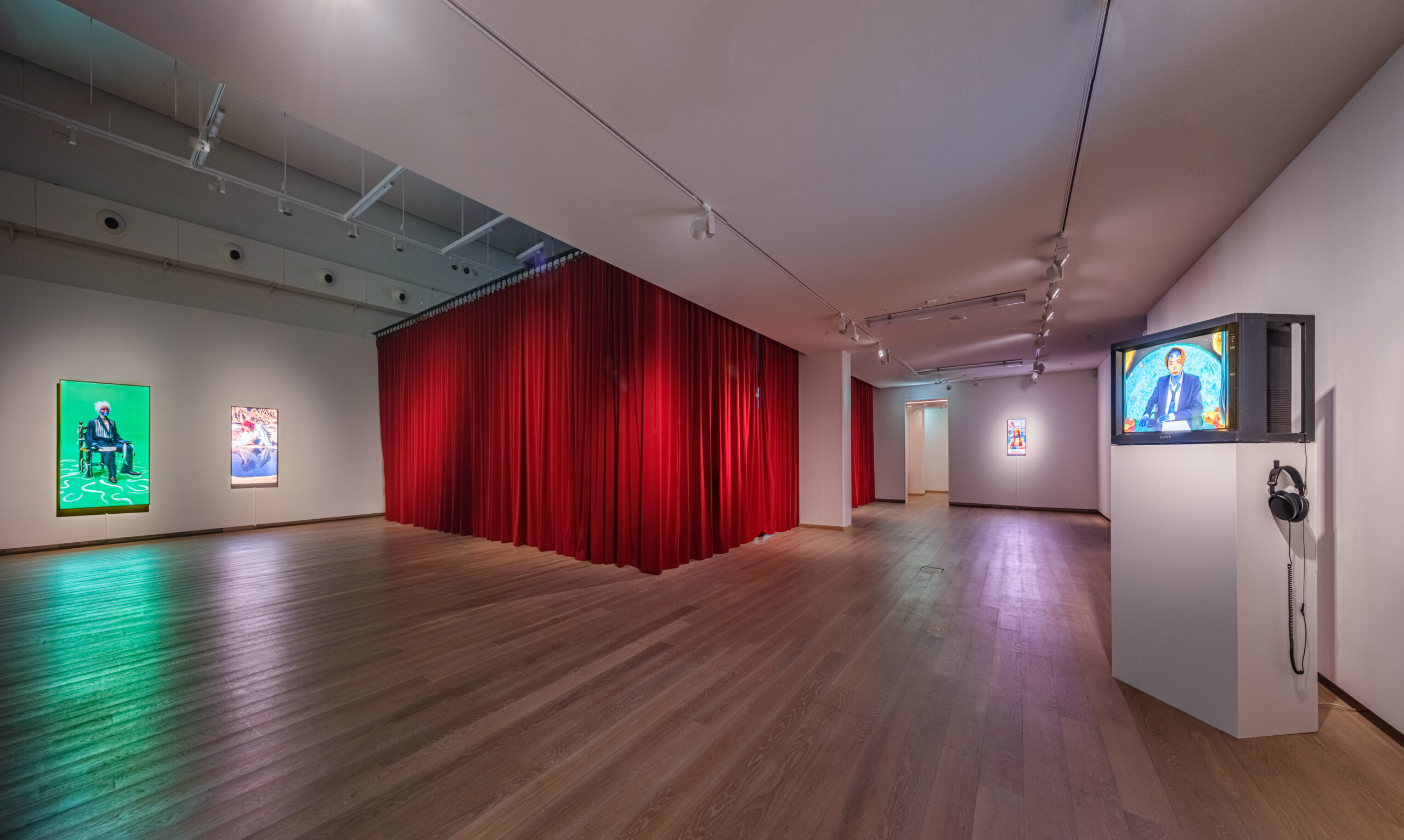
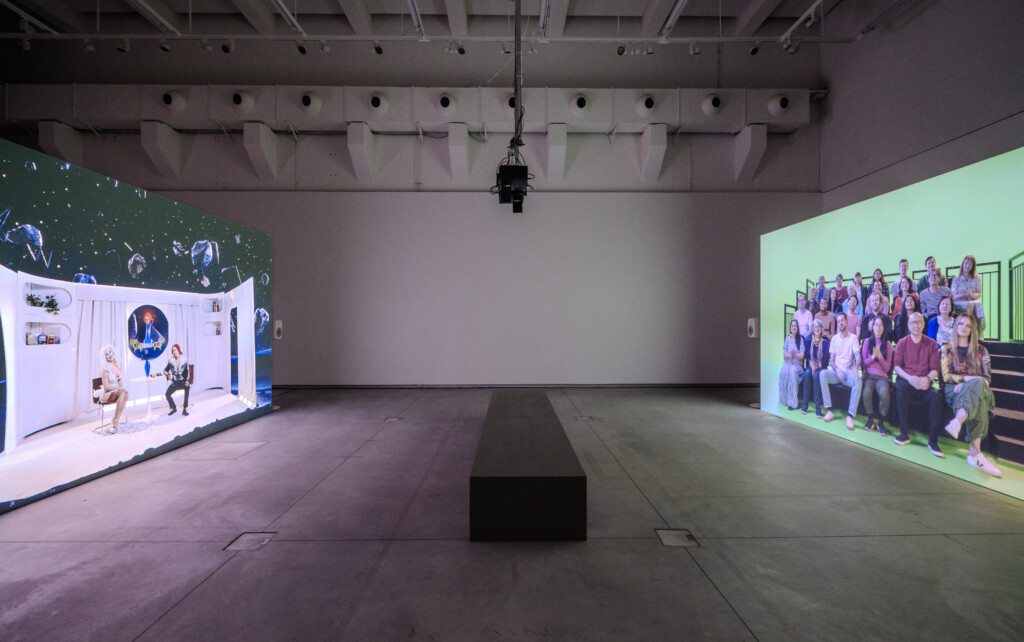
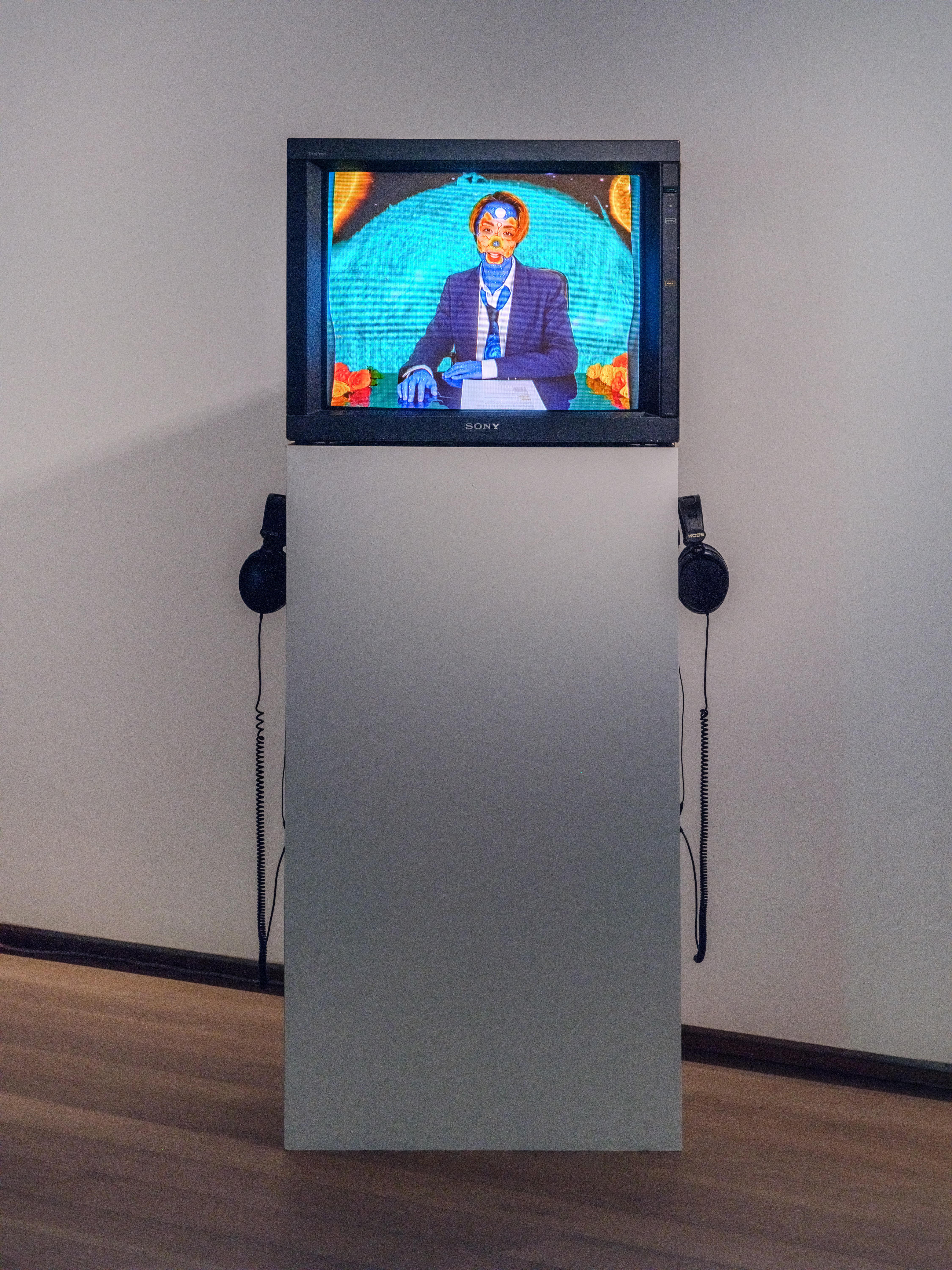
Works in the exhibition
Today’s Top Stories, 2020
The Storyteller is a central character in Sin’s practice and is also the interconnecting agent in this exhibition, appearing in four works. In Today’s Top Stories, The Storyteller appears in the role of a news anchor. With elaborate reporter’s manners they make philosophical propositions on existence, consciousness, and identity. As the broadcast progresses, the sentences crackle and their statements appear unstable. The Storyteller is a trickster, an unreliable narrator rattling off truisms that contradict themselves and affirm multiple contrasting realities. Sin developed this character to work through powerlessness in the face of how hegemonic media narratives, that appear as licensed truth, are held in place through linguistic shifts. This character positions storytelling as a subjective act that can be performed by anyone.
Wai King, 2023
Wai King is the artist’s drag king persona and their space to explore masculinity. Here, Wai King appears as a hypermasculine take on the baroque painter Caravaggio’s (1571-1610) portrait of Narcissus (ca. 1597-1599). The Narcissus myth, well portrayed throughout art history, is about a young man so beautiful that every person who saw him fell in love with him. He has come to symbolise the self-absorption of male arrogance rejecting all declarations of love and falling in love with his own reflection, unable to tear himself away from it. Encountering one’s own reflection is also an archetype in psychoanalysis known through Jaques Lacan’s concept of the mirror stage in which the child sees itself in the mirror and the self emerges through the other (its own reflection). In Sin’s world building, intersubjective relationships and the impossibility of a subject’s disconnection from its surroundings are emphasised as a counter-image to individualism’s hold on the present.
Change, 2023
Change’s face is a butterfly with many wide-open eyes on its flared wings. The character was conceived during a time when the artist was going through many changes in their life parallel to worldwide societal changes brought by the pandemic. Change evades a static mode of being and rejects the boundaries of either/or. In this work, Sin channels Frida Kahlo’s (1907 – 1954) Self-Portrait with Cropped Hair (1940). Kahlo, who often depicted herself with feminine attributes, has in this portrait painted herself wearing an oversized men’s suit and with her locks and plaits of hair spread out on the floor. It was a painting she made in a moment of personal transformation, just months after her divorce.
The Storyteller, 2023
The Storyteller is posing as an otherworldly version of Leonardo Da Vinci’s Mona Lisa (ca 1503–1506). This world-famous painting has long been charged with the ambiguity of the smile and the mystery of who the person depicted actually was, and the interpretations and narratives around her are countless. By having The Storyteller assume the role of news anchor, adopting the pose of the enigmatic Mona Lisa, Sin equates art history to a site of projection and myth-making.
Asleep, 2024
This portrait depicts the character V Sin sleeping. V Sin is Sin’s very first character. This bombshell drag persona was created as they negotiated their relationship with western femininity, picking it apart through parody. Sin often returns to the Taoist allegory Dream of the Butterfly by Zhuangzi (Chuang-tzu) (369 BCE to 286 BCE). Asleep departs from this story in which a man wakes up from a dream of being a butterfly and questions whether he is a man dreaming he’s a butterfly or a butterfly dreaming he’s a man. The position of this portrait serves to enhance the sitcoms characters’ negotiation of what and where they are.
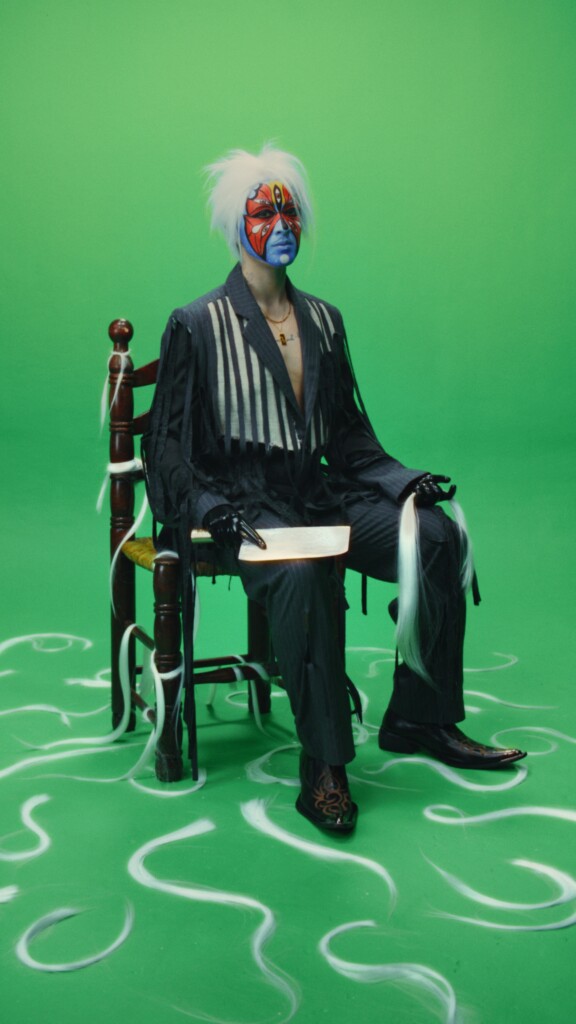
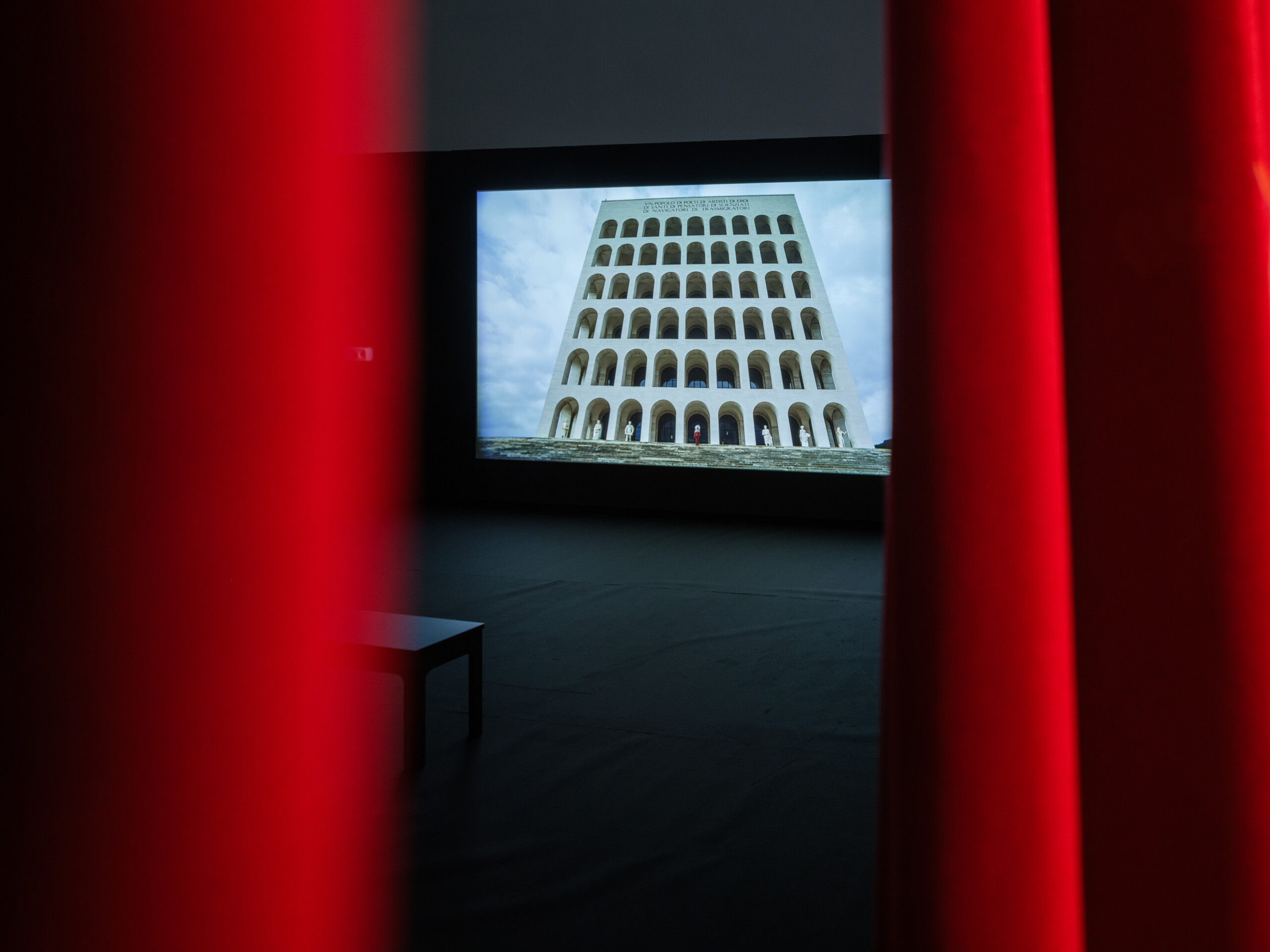
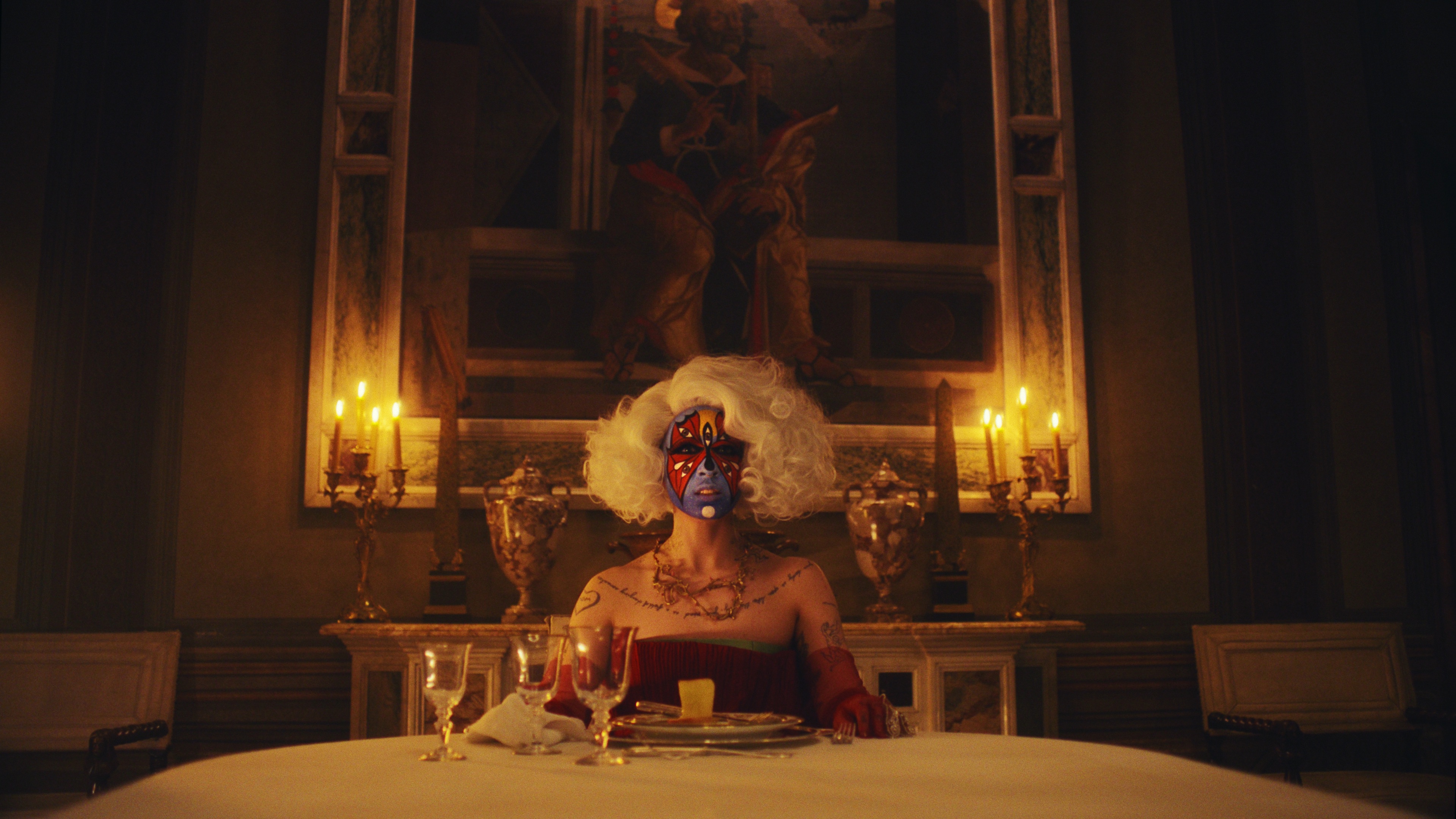
Dreaming the End, 2023
In Dreaming the End, the characters and the story are in constant cyclical metamorphosis, carried through cinematic genre tropes. It is a work sprung from Sin’s interest in how we are born into stories that we ourselves repeat and embody.
Dreaming the End focuses on language as a system designed to keep hegemonic structures in place. The word name takes over large parts of the dialogue, demonstrating how the act of naming is an exercise of power that attempts to keep things, identities and relationships fixed. Sin lets the word be repeated to the point of absurdity where it is deprived of meaning and function and merely serves as a placeholder for a possible different system of language.
In a dinner scene, the character Change breaks out of The Storyteller’s patronising monologue and escapes the fascist architecture to emerge in a new guise in a dreamlike garden. The division between persona and topos, self and world starts to dissolve as the monologue is narrated by various sculptures and the garden becomes an equal protagonist. Change roams freely and encounters, among others, a sculpture of Janus – the Roman god associated with passages, rebirth and duality. His two heads observe both the future and the past. Through this encounter and the words articulated, Change is reborn as The Storyteller. Their subjectivity is formed through vocalisation as they locate themselves in language before facing a mirror that solidifies their own subject as separate from the other, and the narrative begins again.
The Time of Our Lives, 2024
In the new two-channel video installation The Time of Our Lives, a science fiction sitcom unfolds in front of a ‘live’ studio audience. Channelled through the language of daytime TV, and drawing from theories of quantum mechanics and general relativity, the work uproots the concept of absolute time as a means to challenge assumptions about objective truth and reality.
In this domestic setting, moments from the lives of the couple V Sin and Wai King unfold through sequences beyond linear chronologies. A doomsday clock harkening the end of the world and another denoting the categories of past, present or future glitch, jumping forwards and backwards through time and creating uncertainty about what is cause and what effect. Every now and then the couple’s TV switches on by itself and The Storyteller interrupts the dialogue. One of the truisms narrated by The Storyteller also serves as a point of departure for the work: The ways in which we are conditioned to experience time are reflected in the ways that we think, talk about and conceptualise our relationships with others, the world and the universe!
The audience position is set between the two screens of drama and spectator, between performance and what could be authenticity within cycles of acting and being perceived. It is an uncertainty that Sin lets permeate the work and that V Sin and Wai King also juggle; are they awake or dreaming, in whose reality are they acting?
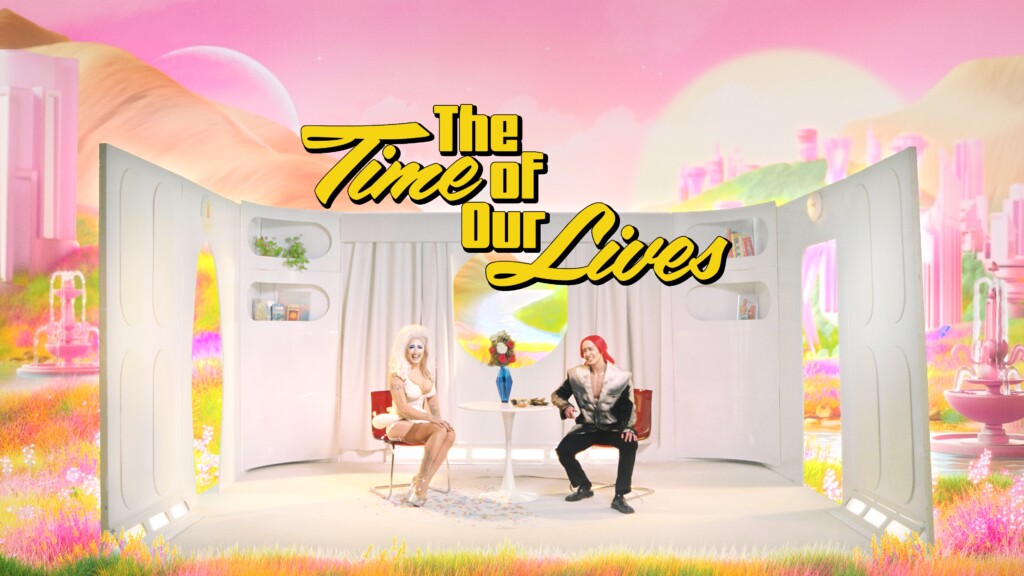
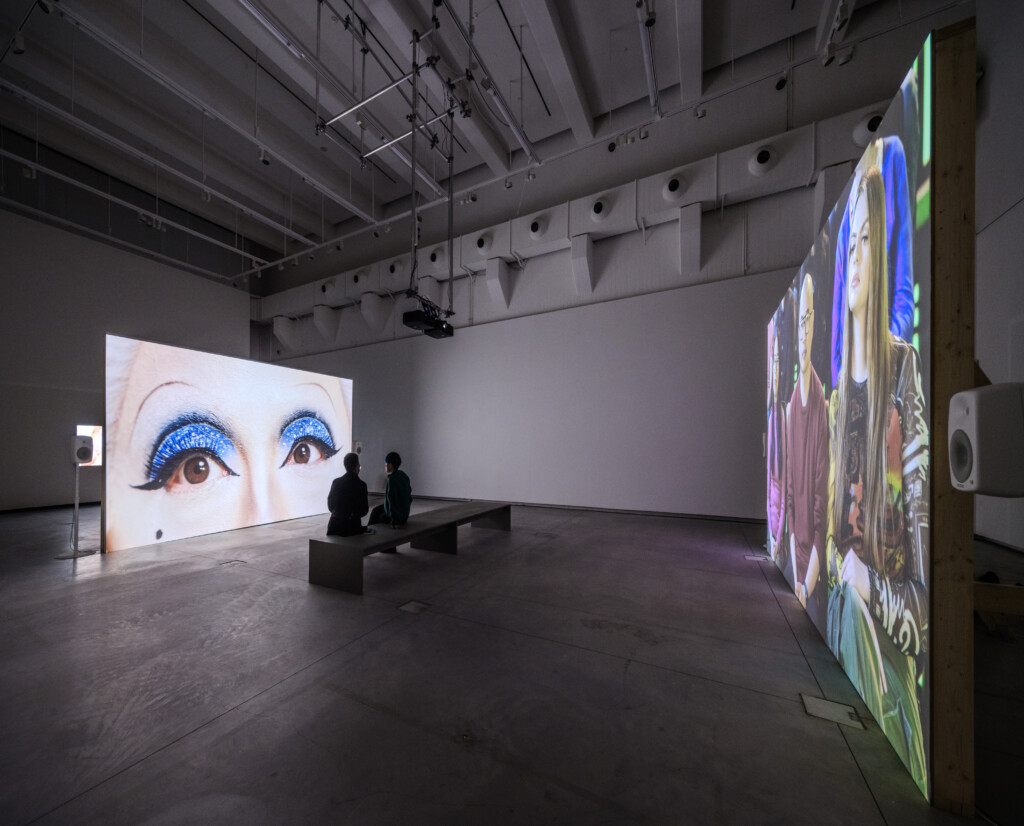
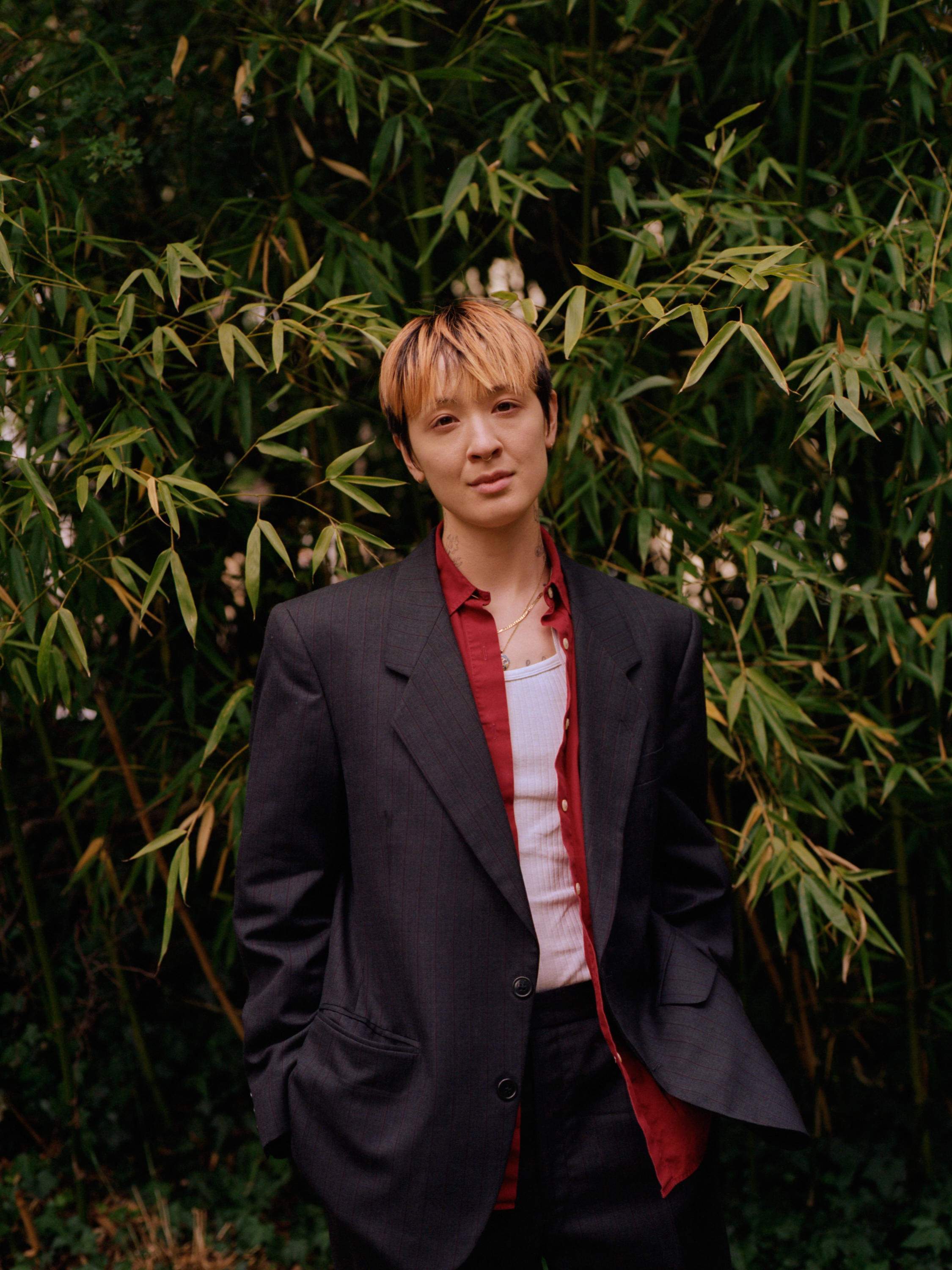
About Sin Wai Kin
Sin Wai Kin (b. 1991, Toronto, CA) brings fantasy to life through storytelling in moving image, performance, writing, and print. Drawing on experiences of existing between binary categories, their work realises alternate worlds to describe lived experiences of desire, identification and consciousness.
The artist was awarded the 24th Baloise Art Prize at Art Basel 2023 and was nominated for the 2022 Turner Prize. The new work The Time of Our Lives will be shown in forthcoming solo exhibitions at Kunsthall Trondheim, Canal Projects NYC and Blindspot Gallery, Hong Kong all in 2025.
Sin Wai Kin has held solo exhibitions and performances at MUDAM, Luxembourg (2024); Buffalo AKG Art Museum, Buffalo(2024); Berkeley Art Museum & Pacific Film Archive, Berkeley (2023); Fondazione Memmo, Rome (2023); Somerset House, London (2022); Solomon R. Guggenheim Museum, New York (2022); Museum of Contemporary Art, Zagreb (2020) Palais de Tokyo (Paris, 2019), Serpentine Galleries, (London, 2019), and Taipei Contemporary Art Centre, Taipei (2018).
Their work is held in several major collections, including the Tate Collection, the British Museum – Prints and Drawings Department, London; the Buffalo AKG Art Museum, Buffalo; and M+ Museum, Hong Kong.
Credits
Curator: Therese Kellner
The Time of Our Lives, 2024
Sin Wai Kin’s new video work The Time of Our Lives (2024) is initiated by Accelerator and co-produced with Kunsthall Trondheim, Canal Projects (New York) and Blindspot Gallery (Hong Kong), and supported by Vince Guo.
Producer: Samantha Wolf
Producer: Maya Dufeu
1st AD: Ffion Kunz at Callbox
2nd AD: Morris Pusey at Loop Talent
AD Runner: Anna Saracka
Director of Photography: Rosie Taylor
1st AC: Lucie Seymour at Suz Cruz
2nd AC / DIT: Chloe Goument
Gaffer: Hollie Mapp at Loop Talent
Sparks: Luke Makepeace, Bert Hurtado, Rufai Ajala at Loop Talent
Sound: Leon James Radschinski
Stock music: POND5
Stylist: Matt King
Stylist Assistant: Fraser Kenneth
Makeup Assistant: Luke Slyka
Hair Stylist: Shunsuke Meguro at Future Rep
Hair Stylist Assistant: Motoharu Iwaizumi
Production Designer: Fillo Deportaberta
Production Design Assistants: Maria Abad, Molly Bonnell, Knives
Seating: Steel Deck
Casting Director: Gemma Gurvitz at Talent Talks
Medics: GWAS Ambulance Group
Catering: Honey and Thyme
Edit Producer: Naike Mabois-Thomas at Avenues
Assistant Editor: Matthew Dilworth at Avenues
CGI producer and agent: Charlotte Öström at CharlieCharlie Agency
CGI post-production: Double Up Studio
Colour Producer: Alex Carswell at Electric Theatre
Colourist: Andi Chu at Electric Theatre
Graphic Designer: Aries Moross
A special thanks to: Pixipixel Rental Limited and SHL London
Dreaming the End, 2023
Commissioned by: Fondazione Memmo
Executive Production: Mira Productions Srls
Executive Producer: Lorenzo Dionisi
Line Producer: Orsetta Paolillo
Assistant Director: Simone Coppo
Director of Photography: Sara Purgatorio
Focus Puller: Cristian Valeri
Assistant Camera: Sibilla Mercuri
Gaffer: Massimo Moreschini
Electrician: Antonio La Barbera
Sound: Roberto Falessi
Data Manager: Tina Rinaldini
Set Designer: Filippo Loy
Costume Designer: Simona Scaloni
Costumes: Robert Wun, Emanuela Pagliarini, Roberto Capucci
Jewelry Artist: Maurizio Savini
Makeup Assistant: Lucrezia Ramundi
Wigs: Yuho Kamo, Naomi Fuller
Editing and FX supervisor: Ugo Piva
Colourist: Andi Chu
Sound Designer and Sound Mix: Leon R. James
Book Cover and Poster Design: Aries Moross
Studio Assistant: Samantha Wolf
Special thanks to: Alessio Antoniolli; Accademia di Francia a Roma – Vila Medici; Fendi; Mahsa Razavi; Sonia Perticara; Anna Gagliardi; R.E.C. Rental Equipment Cine 1 I.M.A.R. Italia; Blindspot Gallery, Hong Kong; Soft Opening, London; Flavia Manacorda; L’arte del plexiglass sils; Ugo Moroni; Alberto Magni / MAG – JLT assicurazioni; Selena Scarano; Roberta, Carlo e Matteo
Portraits, 2023
Commissioned by: Soft Opening, London
Producer: Samantha Wolf
DoP: Ailsa Aikoa
1st AC: Joel Spence
2nd AC/ Gaffer: Dee Iskrzynska
Production Assistant: Zia Knives Zohra
Art Department: Fillo Deportaberta
Stylist: Matt King
Stylist Assistant: Shaylyn Gilheaney
Makeup Assistant: Luke Harris
Hair Stylist: Yuho Kamo
VFX: Rose Pilkington
Colourist: Andi Chu
